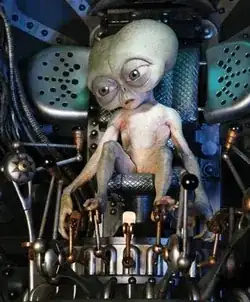I'm not sure how small we're talking, but take a look at chimpanzees.
Now if you had a chimpanzee become more intelligent (i.e. more synapses and more oxygen-rich blood flowing to the brain, as well as heat dispersion), for reasons such as gaining an advantage over other species or navigating complex and ever-changing environments, it would be quite imaginable.
Ignore this ramble, left it here for documentation's sake:
The main issue I spot is heat dispersion, since the surface area is considerably small when compared to the volume of the head. Some of the heat may be transported through the blood, perhaps leading to large ears (such as in African elephants or desert foxes) or tongues (thing panting dogs) to dissipate the heat.
A more exotic solution might be to shape the skull in such a way as to increase the surface area, perhaps with deep wrinkles or folds, though this may come with structural integrity issues, and will not transport the heat in the center to the surface very quickly. It may also impede the room for the organs, perhaps even causing a split brain for a U-shaped skull.
Other than that I don't see a problem whatsoever.
EDIT:
I'm completely wrong as pointed out in the comments, it's the larger the animal the harder it is to manage heat. Pity though, may have been interesting.
EDIT 2:
Perhaps the smallest primate is the Philippine tarsier, with a length of only 85 to 160 mm and a weight of around 80–160 g, so if you just want a humanoid, adjust the muscle distribution to make it walk and remove the tail and presto, you have a small, furry, ugly-looking humanoid.

If it needs to be as 'smart' as a human however, my maths runs dry.
The human brain has a volume of roughly 1200 cm3 an a weight of around 1.3kg, containing about 100 billion neurons (let's ignore the protective cells) each with a diameter of around 4 to 100 micrometers (um), allow us to assume an average diameter of 2 um (because a lot of them are small and we're cramming them in properly), so each neuron is roughly 30 um3 in volume.
Now 100 billion neurons times 30 um3 is 3 million cm3, which is more than 2500 times the volume of the human brain, so either my calculations are entirely broken or the human brain is already really cramped.
This also ignores the fact that the human brain consumes around 20 W per day, which is around 100 kcal per day (roughly a large modern apple), and that further ignores the energy required to carry such a massive brain and the energy required to hunt down the aforementioned apple, which a small creature may have difficulty with.
If anyone can correct me, please do! Hope this helps.



